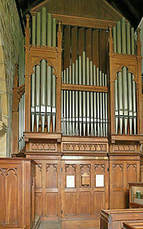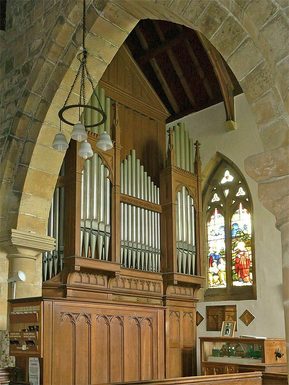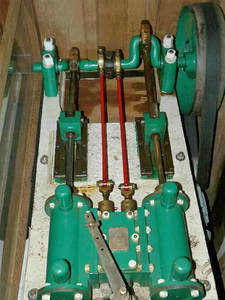Country church curiosity
A Walcker organ nestling in a North Yorkshire country church provides a delightful surpise for the casual visitor expecting something, well, a little smaller. David Bridgeman-Sutton is happy to be taken aback.
|
All organ-lovers know the exhilaration of finding a really interesting instrument in an unexpected place. The Yorkshire village of Felixkirk is a few miles East of Thirsk (in James Herriot country for those interested in veterinary matters).
It has an excellent pub (The Carpenters' Arms) and an unusual church dedicated, as one might expect, to St Felix. Promising though this is from without, it hardly prepares the organ-buff for what will be found within. |
Dominating the West end, from floor to roof, is a large organ-case (picture 1). Particularly striking is the gabled swell-box with its vertical shutters, a first-class piece of cabinet making and an integral part of the overall design. (Usually, such things are treated as embarrassing accessories that must be painted grey and hidden away like chamber-pots in bedrooms of cheap hotels.) This one is tall enough to accommodate, unmitred, full-length basses of open 8 foot stops and speaks, unimpeded, over the unenclosed Great. The handsome case pipes with their French mouths form the basses of open 8- and 16- foot stops. The whole arrangement emphasizes the advantages enjoyed by builders who don't have to squash everything into a cramped organ-chamber.
The builder here, in 1890, was Walcker of Ludwigsburg: both tonal scheme and layout reflect continental practice. An informed commentary, specification and other technical data are to be found here.
The builder here, in 1890, was Walcker of Ludwigsburg: both tonal scheme and layout reflect continental practice. An informed commentary, specification and other technical data are to be found here.
|
Picture 2 gives a view from a different angle. In this, a display case apparently containing a model steam engine is visible. In fact, the “model” is the hydraulic engine that provided power to the bellows for about seventy years until superseded by an electric blower in the 1960s. It is of an interesting pattern quite different from the far more numerous single-cylinder machines of Joy's pattern. |
Picture 3 gives an overview of the engine which was made by William Speight of Leeds.
The admission of water to and its release from two double-acting cylinders (painted green, foreground) is controlled by piston valves placed between them. These are operated by the red-painted rods, actuated by excentrics on the crankshaft. With mains water pressure instead of steam as the motive force, working speeds would not have been high; they were finely adjusted to varying demands made on the wind supply by the silver-coloured lever (foreground) which was operated by the rise and fall of the main reservoir.
The driving pulley is seen top right in the picture, together with a section of the broad leather belting that drove another pulley connected to the bellows. Hydraulic equipment usually worked quietly: it is probable that the greatest sound made by this plant was the click of the rivets or hinge fastening the ends of the belt together, as they hit the driving and driven pulleys alternately.
As mentioned in the article referred to above, three pairs of bellows were used to raise the wind. In the same year that the Walcker was built, a rotary blower of this description was patented and illustrated in The Engineer. This is reproduced here and probably gives a good idea of what the original system at Felixkirk was like.
In its way, the hydraulic engine is as lovely a piece of craftsmanship as the organ itself. Many engineers could spend happy hours watching it at work – something that cannot be said for its admittedly more convenient electric successor. The organ is superb – and worth some effort to see and hear, as it was in the late 1960s when I heard it in its then decrepit state.
As mentioned in the article referred to above, three pairs of bellows were used to raise the wind. In the same year that the Walcker was built, a rotary blower of this description was patented and illustrated in The Engineer. This is reproduced here and probably gives a good idea of what the original system at Felixkirk was like.
In its way, the hydraulic engine is as lovely a piece of craftsmanship as the organ itself. Many engineers could spend happy hours watching it at work – something that cannot be said for its admittedly more convenient electric successor. The organ is superb – and worth some effort to see and hear, as it was in the late 1960s when I heard it in its then decrepit state.
David Bridgeman-Sutton, 2009
Postscript: A note in the display case reads "This hydraulic engine was originally used to operate the bellows for the Felixkirk organ. It used the water from the surrounding hills through the Mount St John system." Mount St John was the local “big house” the owners of which gave the Walcker to St Felix church. For a similar water system see figure 3 here .
CREDITS: Thanks to Barrie Sidebottom of Felixkirk for the use of his photographs and for patience in answering questions.
CREDITS: Thanks to Barrie Sidebottom of Felixkirk for the use of his photographs and for patience in answering questions.




